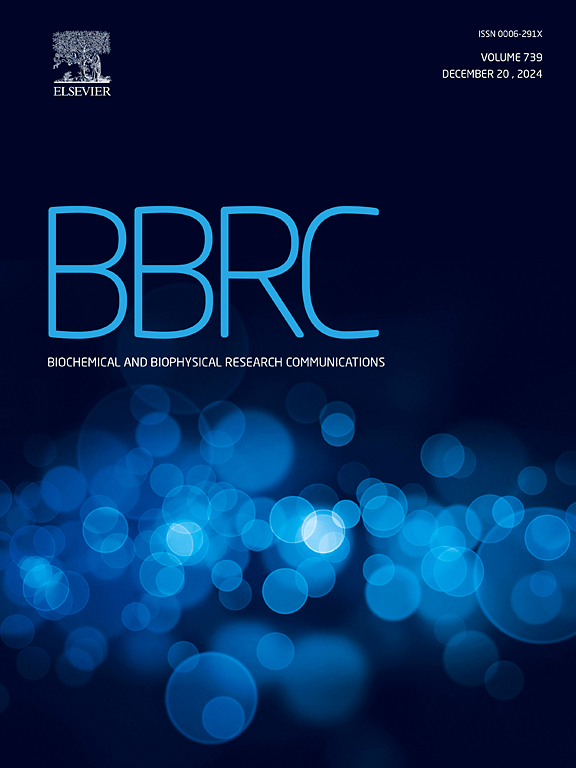SARS-CoV-2木瓜蛋白酶通过切割TBK1部分抑制dsrna诱导的I型干扰素反应
IF 2.2
3区 生物学
Q3 BIOCHEMISTRY & MOLECULAR BIOLOGY
Biochemical and biophysical research communications
Pub Date : 2025-06-21
DOI:10.1016/j.bbrc.2025.152244
引用次数: 0
摘要
严重急性呼吸综合征冠状病毒-2 (SARS-CoV-2)感染已夺去数百万人的生命,自出现以来已成为全球威胁。多种sars - cov -2编码蛋白已被证明可发挥干扰素- i (IFN-I)拮抗作用,这有助于严重的发病机制。我们之前报道过SARS-CoV-2和SARS-CoV(一种密切相关的高致病性冠状病毒)的木瓜蛋白酶(PLpro)通过其去泛素化(DUB)活性来抵消IFN的产生。在这项研究中,我们揭示了SARS-CoV-2负性调节宿主先天抗病毒反应的新机制。来自SARS-CoV和SARS-CoV-2的PLpro蛋白都介导了IFN-I信号通路中枢纽激酶TBK1的蛋白水解裂解。利用点突变体,我们证明了由C111、H272和D286组成的催化三联体和酶活性调节位点W93对于SARS-CoV-2 PLpro切割TBK1蛋白的能力和对TBK1触发的IFN表达的抑制作用至关重要。然而,突变体未能消除SARS-CoV PLpro对仙台病毒(SeV)诱导的IFN- i启动子激活的抑制作用,这表明PLpro部分通过切割TBK1来抑制dsrna诱导的IFN应答。总之,我们的研究结果表明,高致病性SARS-CoV和SARS-CoV-2利用其PLpro蛋白在TBK1水平上抑制IFN的表达,从而导致宿主先天抗病毒反应的逃避,这是一种保守的机制。本文章由计算机程序翻译,如有差异,请以英文原文为准。
Papain-like protease of SARS-CoV-2 inhibits dsRNA-induced type I interferon response partly by cleaving TBK1
Severe acute respiratory syndrome coronavirus-2 (SARS-CoV-2) infection has claimed millions of lives and has been a global threat since its emergence. Multiple SARS-CoV-2-encoded proteins have been shown to exert interferon-I (IFN–I)-antagonizing effects, which contribute to severe pathogenesis. We previously reported that the papain-like protease (PLpro) of SARS-CoV-2 and SARS-CoV, a closely related highly pathogenic coronavirus, counteracts IFN production via its deubiquitinating (DUB) activity. In this study, we reveal a new mechanism by which SARS-CoV-2 negatively regulates host innate antiviral responses. Both PLpro proteins from SARS-CoV and SARS-CoV-2 mediated the proteolytic cleavage of TBK1, the hub kinase in the IFN-I signaling pathway. Using point mutants, we demonstrated that the catalytic triad, which is composed of C111, H272, and D286, and the enzyme activity regulatory site, W93, are essential for the ability of SARS-CoV-2 PLpro to cleave the TBK1 protein and for the inhibitory effect on TBK1-triggered IFN expression. However, the mutants failed to abrogate the suppressive effect of SARS-CoV PLpro on Sendai virus (SeV)-induced IFN-I promoter activation, indicating that PLpro inhibits the dsRNA-induced IFN response partly by cleaving TBK1. Collectively, our findings suggest a conserved mechanism through which highly pathogenic SARS-CoV and SARS-CoV-2 harness their PLpro proteins to suppress IFN expression at the level of TBK1, resulting in the evasion of the host innate antiviral response.
求助全文
通过发布文献求助,成功后即可免费获取论文全文。
去求助
来源期刊
CiteScore
6.10
自引率
0.00%
发文量
1400
审稿时长
14 days
期刊介绍:
Biochemical and Biophysical Research Communications is the premier international journal devoted to the very rapid dissemination of timely and significant experimental results in diverse fields of biological research. The development of the "Breakthroughs and Views" section brings the minireview format to the journal, and issues often contain collections of special interest manuscripts. BBRC is published weekly (52 issues/year).Research Areas now include: Biochemistry; biophysics; cell biology; developmental biology; immunology
; molecular biology; neurobiology; plant biology and proteomics

 求助内容:
求助内容: 应助结果提醒方式:
应助结果提醒方式:


